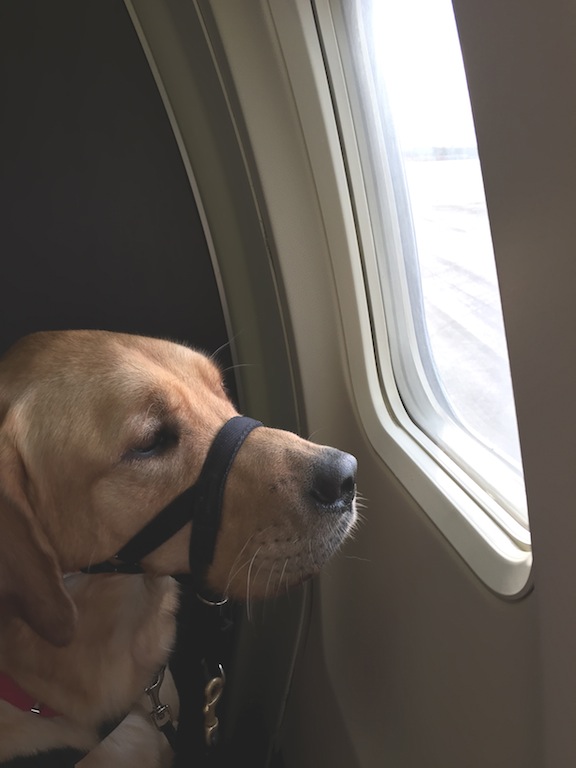
Important Travel Tips for Service Dogs
By Judy Keene, Next Step Service Dogs
Trained to be incredibly adaptable and calm, service dogs are trained to go everywhere possible with their owner/client. Many clients of Next Step Service Dogs can now rejoin the world — hike, camp, attend events, fly, and go places with a sense of safety that their PTSD/TBI service dog provides. Here are tips about traveling with a service dog to make each new adventure as easy as Sunday morning.
GETTING AIRPLANE TICKETS & NOTIFYING THE AIRLINE
• Schedule your trip on flights that are not full. It is best to book late night and midnight flights where you can have an empty seat between you and another passenger. Your dog MUST NOT sit on any seat but the extra space gives good stretching and easy sleeping in the footwells.
• Service Dog Question: Be prepared to answer the question: “ What tasks does your service dog perform to help with your disability?”
• When you book your tickets, find out what they require from you. Each airline has a slightly different protocol; some require documentation, others do not, but all require notification ahead of time. A service dog does not automatically get onto a flight. All airlines have a limited number of service animals per flight so you must confirm that your service dog can board.
• Traveling to Hawaii: Plan at least 6 months prior to any trip to Hawaii with a service dog – you must submit paperwork proving that your dog has two rounds of rabies vaccine and is a certified service dog – this can take 3 months or more. If you do not have the proper authorization when you land, the dog will be quarantined for 180 days with an expensive bill to go with it.
• If you travel to another country, research the additional requirements. For example, flights to Australia and England only allow ADI-member accredited service dogs on their flights; some countries allow no dogs.
• At least one or two weeks before your flight, confirm that your dog is registered and approved in the airline’s database and is expecting your dog. United Airlines issues a service dog pass; other airlines may start doing them also.
PREPARATION BEFORE THE FLIGHT
1. Do a few trial runs visiting the airport the weeks before your flight, make sure that your dog and you are comfortable with escalators, elevators, crowds with baggage, little children, and little dogs, and all the sounds there.
2. Groom/clean your dog within a couple of days prior to the flight.
3. Get a health check by a veterinarian especially for your dog’s ears, a few days before your flight. If your dog has even a small ear infection, it could cause pain and extensive howling and whining during the flight – worth avoiding!
4. If your dog (or your dog’s breed) has a delicate stomach under stress, gets car sick or sea sick with movement, check with your veterinarian on how to best keep your dog calm before and during the flight.
5. Bring:
• a copy of all your dog’s medical records with you in case you need to visit a veterinarian during your visit
• plenty of wipes and poop bags
• a portable water bowl, food, and high value snacks for your dog to have ready when you land.
6. Have a bully stick for your dog to chew just before the dog’s first airplane ride taking off, to pop his ears as the plane gains altitude. This is usually only needed for the first time; once the newness wears off, the dogs naturally relax and will yawn to pop their ears on later flights.
THE AIRPLANE FLIGHT
Moose takes a peak out the window before takeoff
Bo relaxes at the feet of his veteran
• NO FOOD OR WATER at least for 6 hours before the flight (longer if there is a delicate stomach), so that you can fully toilet your dog shortly before boarding.
• DO NOT ALLOW your dog to sit on a seat. He must be in the footwell at all times no matter how squished you both might feel. It is do-able!
• Be aware of small dogs and other service dogs on the flight. Your dog must not react to other dogs by barking, whining, lunging, or any disruptive behavior. Just control your dog at all times, and quietly distract him when needed.
• VERY IMPORTANT: When you locate your seat, check with neighboring passengers. If any of them dislike dogs or are allergic to dogs, ask the flight attendant to move your seat.
• If you are on an aisle seat with your service dog, use your feet as a barrier between the dog and the aisle. It is critical that the dog is kept separate from any pathways or passengers. His tail, feet, and body must not slip onto the aisle or into the space of another passenger.
• NO food or water to your dog during the flight.
• As soon as the plane lands, IMMEDIATELY TOILET your dog outside or at a dog toilet area PRIOR to getting your luggage. It is no fun to have a poop pile in the luggage area.
Based in San Diego County, Next Step Service Dogs is a 501(c)3 nonprofit that trains and certifies amazing service dogs for active military, veterans, and first responders with PTSD and Traumatic Brain Injury (TBI), at no cost to the client. See www.nextstepservicedogs.org.




